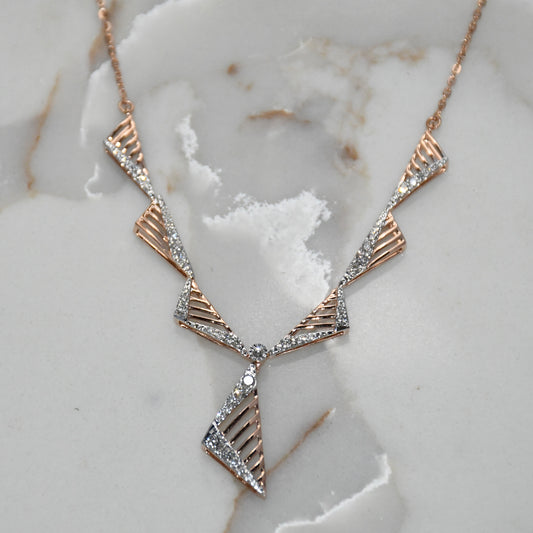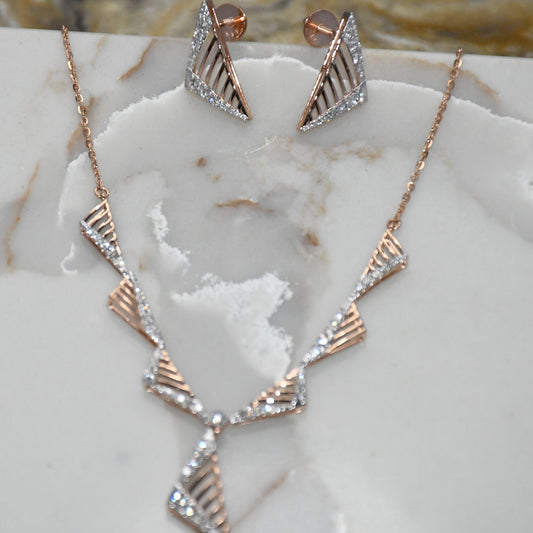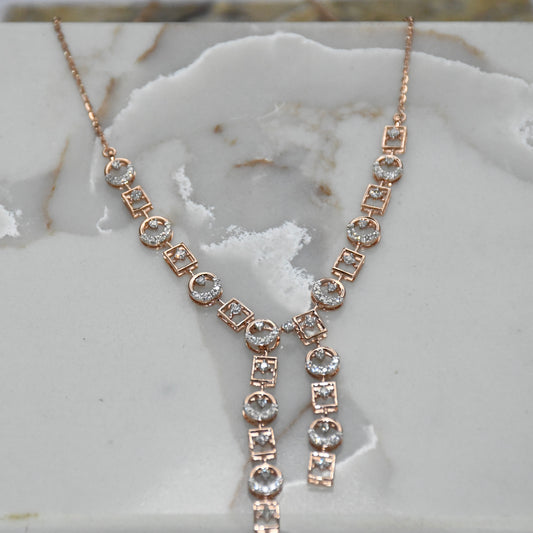First-Time Buyer's Guide to Lab-Grown Diamonds: CVD vs. HPHT Methods
Share

Thinking about a lab-grown diamond? Great choice. First things first—these aren't fake diamonds or look-alikes. Lab-grown diamonds are the real diamonds- chemically, physically, and optically identical to their natural counterparts.
There are two main ways to create them: CVD (Chemical Vapor Deposition) and HPHT (High-Pressure, High-Temperature). Both make beautiful, authentic diamonds, but they're a bit different from each other. I'll walk you through what makes them different so you can figure out which one is right for you and feel good about your decision.
How Are Lab-Grown Diamonds Made?
Understanding how lab-grown diamonds are created is the first step to appreciating their unique qualities. Each method is a marvel of scientific precision, designed to either replicate or build upon nature's own diamond-forming process.
Prefer something versatile for everyday style? View our lab-grown diamond bracelet collection to find the perfect piece that transitions effortlessly from day to night.
CVD (Chemical Vapor Deposition) Method
The CVD method, which stands for Chemical Vapor Deposition, is a process of addition. Think of it like an incredibly precise 3D printer building an object atom by atom. The carbon atoms are the "ink," depositing onto the seed and perfectly replicating its crystal structure, layer by microscopic layer.
The process begins with a "seed"- a very thin slice of an existing diamond that is placed inside a sealed vacuum chamber. The chamber is filled with carbon-rich gases like methane and heated to extreme temperatures. This causes the gases to break down and form a glowing plasma. From this plasma, carbon atoms precipitate and deposit onto the diamond seed. Over several weeks, a beautiful, high-quality diamond is formed.
HPHT (High-Pressure, High-Temperature) Method
The HPHT method, which stands for High-Pressure, High-Temperature, mimics the intense geological conditions that form diamonds deep within the Earth's mantle. Imagine making rock candy, where you dissolve sugar in hot water and let it crystallize onto a string. The HPHT process is similar: a solid carbon source, like graphite, is dissolved in molten metal, and under the intense heat and pressure, the carbon atoms recrystallize onto the diamond seed, building a new, pure diamond crystal.
This process starts with a diamond seed placed in a press with a carbon source. The chamber is subjected to immense pressure- around 1.5 million pounds per square inch- and extreme heat, typically around 1,500°C. These conditions cause the carbon to melt and crystallize onto the seed, growing a new diamond. While both of these scientific methods produce genuine diamonds, their different growth methods result in subtle but important distinctions that can influence your choice.
Ready to see these diamonds in action? Explore our lab-grown diamond jewelry collection to discover how these exceptional stones come to life in stunning designs.
A Practical Comparison
While both CVD and HPHT diamonds are real, their different growth journeys result in unique characteristics. These distinctions are often subtle, but understanding them is key to selecting the perfect stone for you.
This table synthesizes the key differences to help you see how the two types compare at a glance.
Feature |
CVD (Chemical Vapor Deposition) |
HPHT (High-Pressure, High-Temperature) |
|
Clarity |
Generally have fewer and smaller inclusions, resulting in higher clarity grades (VVS or better). |
May contain microscopic metallic inclusions from the metal catalyst used in the growth process. |
|
Color |
As-grown diamonds can have a brownish or greyish tint that often requires post-growth treatment to improve color. |
Can have a yellowish tint due to nitrogen or a faint "blue nuance" due to boron impurities present during growth. |
|
Growth Structure |
Grows in a single direction, creating a flatter, tabular crystal shape with a distinct layered structure. |
Grows simultaneously in fourteen different directions, creating a more complex crystal shape known as a cuboctahedron. |
|
Durability |
Identical to natural diamonds, scoring a 10 on the Mohs scale of hardness. |
Identical to natural diamonds, scoring a 10 on the Mohs scale of hardness. |
The "4Cs" in Detail
Beyond the basic comparison, a diamond's fundamental character is also defined by its scientific classification, or "type," which is based on the presence of chemical impurities. This classification provides a deeper understanding of the differences in Color and Clarity.
Color:
HPHT diamonds can sometimes exhibit a faint blue tint, known as a "blue nuance." This is caused by trace amounts of boron incorporated during growth. This trace of boron classifies these HPHT diamonds as Type IIb, the same classification given to the world's rarest natural blue diamonds, including the Hope Diamond. While the blue nuance is typically very subtle and not graded as a "fancy" color, it is a fascinating chemical signature of its creation.
CVD diamonds, in their as-grown state, tend toward a brownish tint. This is often corrected to make them colorless. This treatment, which often involves subjecting the CVD diamond to HPHT conditions, permanently improves its color to make it colorless.
Clarity:
CVD diamonds are renowned for their exceptional purity. This is because the layered growth process is so controlled that very few internal flaws, or inclusions, are formed. This exceptional purity is why nearly all colorless CVD diamonds are classified as Type IIa, a category of diamond that is free from measurable nitrogen impurities. In nature, Type IIa diamonds—like the famed Cullinan and Koh-i-Noor—are incredibly rare, representing less than 2% of all mined diamonds. This makes the purity of a CVD diamond truly remarkable.
HPHT diamonds can sometimes contain microscopic metallic inclusions, which are remnants of the metal flux catalyst used to dissolve the carbon source during the growth process.
Now that you know what to look for in diamond quality, why not see how stunning these diamonds look when set in a ring? Browse our lab-grown diamond ring collection to find your perfect match.
Carat (Size):
The CVD process allows for highly controlled, layer-by-layer growth, which makes it a very consistent method for producing larger, high-quality diamonds.
These differences in quality and production directly influence one of the most important factors for any buyer: the cost.
Cost: What Should You Expect to Pay?
One of the most significant advantages of choosing a lab-grown diamond is the exceptional value. Both CVD and HPHT diamonds are significantly more affordable than mined diamonds of the same quality, often costing anywhere from 40% to 80% less. This allows you to select a larger or higher-quality stone for your budget.
When comparing CVD and HPHT, there isn't a simple rule that one is always cheaper. While the CVD process itself can be more efficient for growing larger stones, the final market price is determined by the stone's ultimate quality. In fact, due to the high clarity often achieved, a top-tier CVD diamond may command a premium over an HPHT stone of similar size. The most important factor is always the final grade of the individual stone, not its growth method. With a clear understanding of the process, quality, and price, you can now decide which type of lab-grown diamond best fits your personal priorities.
Which Diamond Is Right for You?
The best diamond is the one that aligns with what you value most. Here is a guide to help you decide based on your personal preferences.
Choose a CVD diamond if:
You prioritize the highest possible clarity with minimal internal flaws.
You are captivated by the idea of owning a Type IIa diamond, a class of gemstone prized for its chemical purity and found only among the rarest natural diamonds.
Choose an HPHT diamond if:
You are drawn to the idea of a process that more closely mimics natural diamond formation.
The unique story of a Type IIb diamond, which shares its fundamental chemistry with the world's most famous natural blue diamonds, appeals to you.
Looking for something elegant and timeless? Discover our lab-grown diamond pendant collection for pieces that make a statement with every wear.
For budget-conscious buyers:
Both methods offer outstanding value. The most effective approach is to compare individual diamonds and their certifications. Focus on finding a stone that meets your standards for cut, color, and clarity within your budget, rather than making the decision based solely on the growth method.
Checks for Any Lab-Grown Diamond Before You Buy
Regardless of which type you choose, there are two final steps every buyer should take to ensure a smart, confident purchase.
The Importance of Certification
Always insist on a diamond grading report from a reputable, independent gemological laboratory like the IGI (International Gemological Institute) or GIA (Gemological Institute of America). This certificate is your guarantee of quality.
A proper report will:
- Confirm the diamond's 4Cs (Cut, Color, Clarity, Carat).
- Explicitly state that the diamond is "laboratory-grown."
- Identify the growth method (e.g., "created by Chemical Vapor Deposition (CVD) growth process").
- Note any post-growth treatments, such as HPHT processing, used to enhance color.
If you're drawn to delicate, layered looks, check out our lab-grown diamond necklace collection for designs that beautifully complement any style.
Ethical and Environmental Benefits
One of the most compelling reasons to choose a lab-grown diamond is peace of mind. Both CVD and HPHT diamonds are considered more environmentally friendly and ethical choices compared to mined diamonds. They are inherently conflict-free and avoid the significant environmental damage and ethical concerns associated with traditional diamond mining.
For those who love to make a bold statement, explore our lab-grown diamond bangle collection featuring pieces that add instant glamour to any outfit.
Conclusion
Whether created through CVD or HPHT, a lab-grown diamond is a real, beautiful, and durable gemstone that will last a lifetime. The choice between them is not about which one is "better" overall, but which one is better for you. By understanding the nuances of their creation, appearance, and value, you are now empowered to select a diamond that perfectly aligns with your personal preferences, budget, and values—a brilliant choice you can be proud to wear and treasure.
Want the best of both worlds? Shop our natural & lab-grown diamond jewelry collection to explore the full range of possibilities and find exactly what speaks to you.








